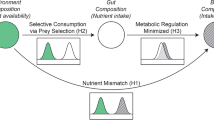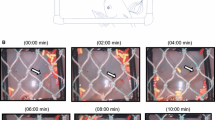Summary
Published studies of consumer feeding preferences using foods that experience autogenic change in mass, numbers, area, etc., on the time scale of a feeding trial fail to employ appropriate statistical analyses to incorporate controls for those food changes occurring in the absence of the consumer. The studies that run controls typically use them to calculate a constant “correction factor”, which is subtracted prior to formal data analysis. This procedure constitutes a non-rigorous suppression of variance that overstates the statistical significance of observed differences. The appropriate statistical analysis for preference tests with two foods is usually a simple t-test performed on the between-food differences in loss of mass (or numbers, area, etc.) comparing the results of experimentals with consumers to controls without consumers. Application of this recommended test procedure to an actual data set illustrates how low replication in controls, which is typical of most studies of feeding preference, inhibits detection of an apparently large influence of previous mechanical damage (simulated grazing) in reducing the attractiveness of a brown alga to a sea urchin.
Similar content being viewed by others
References
Anderson RJ, Velimirov B (1982) An experimental investigation of the palatability of kelp bed algae to the sea urchinParachinus angulosus Leske. PZNI Mar Ecol 3:357–373
Brawley SH, Fei XG (1987) Studies of mesoherbivory in aquaria and in an unbarricaded mariculture farm on the Chinese coast. J Phycol 23:614–623
Brownlee KA (1967) Statistical theory and methodology in science and engineering, second edition. John Wiley and Sons, Inc, New York
Carefoot TH (1973) Feeding, food preference, and the uptake of food energy by the supralittoral isopodLigra pallasii. Mar Biol 18:228–236
Cock MJW (1978) The assessment of preference. J Anim Ecol 47:805–816
Geiselman JA, McConnell OJ (1981) Polyphenols in brown algaeFucus vesiculosus andAscophyllum nodosum: chemical defenses against the marine herbivorous snail,Littorina littorea. J Chem Ecol 7:1115–1133
Hay ME (1986) Associational plant defenses and the maintenance of species diversity: turning competitors into accomplices. Am Nat 128:617–641
Hay ME, Fenical W (1988) Marine plant-herbivore interactions: the ecology of chemical defense. Ann Rev Ecol Syst 19:111–145
Hay ME, Lee RR, Guieb RA, Bennett MM (1986) Food preference and chemotaxis in the sea urchinArbacia punctulata (Lamarck) Philippi. J Exp Mar Biol Ecol 96:147–153
Hay ME, Duffy JE, Pfister CA, Fenical W (1987) Chemical defense against different marine herbivores: are amphipods insect equivalents? Ecology 68:1567–1580
Hay ME, Duffy JE, Fenical W, Gustafson K (1988a) Chemical defense in the seaweedDictyopteris delicatula: differential effects against reef fishes and amphipods. Mar Ecol Prog Ser 48:185–192
Hay ME, Renaud PE, Fenical W (1988b) Large mobile versus small sedentary herbivores and their resistance to seaweed chemical defenses. Oecologia 75:246–252
Himmelman JH (1984) Urchin feeding and macroalgal distribution in Newfoundland, eastern Canada. Naturaliste can (Rev Ecol Syst) 111:337–348
Holmlund MB, Peterson CH, Hay ME (1989) How morphology of algal substratum affects susceptibility of amphipods to pinfish predation. J Exp Mar Biol Ecol (in press)
Lewis SM (1985) Herbivory on coral reefs: algal susceptibility to herbivorous fishes. Oecologia 65:370–375
Littler MM, Littler DS (1980) The evolution of thallus form and survival strategies in benthic marine macroalgae: field and laboratory tests of a functional form model. Am Nat 116:25–44
Littler MM, Littler DS (1983) Heteromorphic life-history strategies in the brown algaScytosiphon lomentaria (Lyngb.) Link. J Phycol 19:425–431
Lubchenco J, Gaines SD (1981) A unified approach to marine plant-herbivore interactions. I. Populations and communities. Ann Rev Ecol Syst 12:405–437
McConnell OJ, Hughes PA, Targett NM, Daley J (1982) Effects of secondary metabolites on feeding by the sea urchin,Lytechinus variegatus. J Chem Ecol 8:1427–1453
Murdoch WW (1969) Switching in general predators: experiments on predator specificity and stability of prey populations. Ecol Monogr 39:335–354
Nicotri ME (1980) Factors involved in herbivore food preference. J Exp Mar Biol Ecol 42:13–26
Paul VJ, Littler MM, Littler DS, Fenical W (1987) Evidence for chemical defense in tropical green algaCaulerpa ashmeadii (Caulerpacea: Chlorophyta): isolation of new bioactive sesquiterpenoids. J Chem Ecol 13:1171–1185
Pfister CA, Hay ME (1988) Associational plant refuges: convergent patterns in marine and terrestrial communities result from differing mechanisms. Oecologia 77:118–129
Pollard SD (1988) Partial consumption of prey: the significance of prey water loss on estimates of biomass intake. Oecologia 76:475–476
Sousa WP (1979) Experimental investigations of disturbance and ecological succession in a rocky intertidal algal community. Ecol Monogr 49:227–254
Sousa WP, Schroeter SC, Gaines SD (1981) Latitudinal variation in intertidal algal community structure: the influence of grazing and vegetative propagation. Oecologia 48:297–307
Steinberg PD (1984) Algal chemical defense against herbivores: allocation of phenolic compounds in the kelpAlaria marginata. Science 223:405–407
Steinberg PD (1985) Feeding preferences ofTegula funebralis and chemical defenses of marine brown algae. Ecol Monogr 55:333–349
Steinberg PD (1988) Effects of quantitative and qualitative variation in phenolic compounds on feeding in three species of marine invertebrate herbivores. J Exp Mar Biol Ecol 120:221–237
Targett NM, Targett TE, Vrolijk NH, Ogden JC (1986) The effect of macrophyte secondary metabolites on feeding preferences of the herbivorous parrotfishSparisoma radians. Mar Biol 92:141–148
Vadas RL (1977) Preferential feeding: an optimization strategy in sea urchins. Ecol Monogr 47:337–371
Vadas RL (1985) Herbivory. In: Littler MM, Littler DS (eds) Handbook of Phycological Methods. Cambridge University Press, Cambridge, pp 531–572
Zimmerman R, Gibson R, Harrington J (1979) Herbivory and detritivory among gammaridean amphipods from a Florida seagrass community. Mar Biol 54:41–47
Author information
Authors and Affiliations
Rights and permissions
About this article
Cite this article
Peterson, C.H., Renaud, P.E. Analysis of feeding preference experiments. Oecologia 80, 82–86 (1989). https://doi.org/10.1007/BF00789935
Received:
Published:
Issue Date:
DOI: https://doi.org/10.1007/BF00789935




